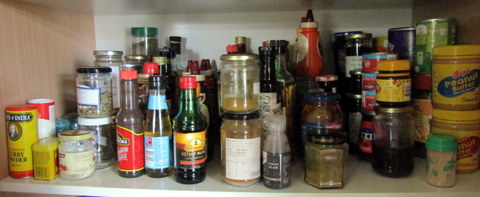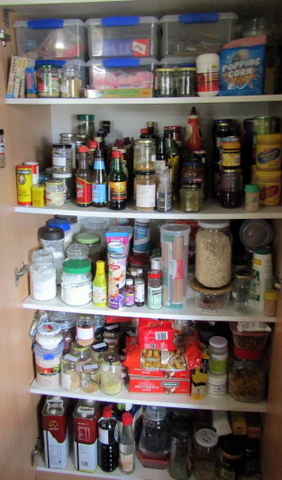Using a pantry audit (and including the fridge) can give you a handle on the food packaging waste you are generating and have on hand, and then provide the information needed to help you start reducing it. Addressing food packing waste is a great way to start on your journey towards zero waste!
It doesn’t take long to do, I did ours in about half to three quarters of an hour, with some extra time taken to sit down and analyse the results. The prime issue is plastic food packaging, especially after all the issues we have been having with sending Australian recyclable plastics overseas, then the receiving countries no longer accepting it. We have little in the way of local processes to recycle it, so now a lot is ending up in land fill. As you conduct your audit, making a note of the type of packaging the food was bought/stored in will make later analysis easier as you can hit the stuff in plastic packaging first.
Also, the frequency you use each item is worth recording so that you can hit the biggest fish first (to coin a mixed metaphor). I did this by using three numbers to set out the highest use stuff –
1. used daily to weekly (high use)
2. used monthly or less (low use)
3. Dead stock. (forget it!)
If you are anything like us you will have dead stock in your pantry. That is to say stuff that we never use and which has been sitting around forever, taking up valuable space in our pantry. It may be dead stock because our tastes have changed over the years, it was something which looked good but when we tried it we found it not to our tastes, or it may be something we over-bought which has gone out of date and we are not game to use it. Or it may be that it was an impulse buy which seemed like a good idea at the time but, if we had thought about it, we would have known it was not really ‘us’. Rare, but it does happen!
To conduct the audit is fairly simple, download the excel spreadsheet I put together, or develop your own, then go through your pantry (and fridge if you want that in your terms of reference) item by item and write down every product in there. Against each item you can also make a note of the packaging type (plastic bag, paper bag, glass jar, cardboard carton, plastic jar etc.) and if you want to be really thorough, the pack size and number of packages which you have. You can then make an estimate of the frequency of use of each item using the one to three scale above. By looking at the amount you store and the usage score it will give you an idea of which items to hit first to get the best bang for your buck in terms of the volume of packaging waste you are generating.
The next trick is to highlight any and all pantry and fridge contents which are in packaging which you find unacceptable. To help you decide how far you want to go, I suggest you consult the hierarchy of packaging, which lists packaging types from the best (ie none) at the top, to the worst (non-recyclable plastics) at the bottom. You decide how far up you want to go.
Once you have developed all this data, it is then a case of analysing it and working out what changes you are going to make. From the work I did with our pantry/fridge audit, it seemed to me that there were four (or in reality five) options that I could see –
The Options
1. Buy a similar product, packaged further up the hierarchy
2. Buy from one of the emerging ‘bulk buy/packaging free’ places
3. Make the product at home (ideally from bulk sourced or home produced raw materials)
4. Use up and not replace
5. Oh yes! I have no idea at the moment!
The Details
The Blind Taste Test
Get hold of a small amount of all the readily available hot sauces, which have been appropriately labelled, from friends and acquaintances or even buy a small container of each. Have someone trustworthy (this is NOT the time for practical jokes!) put a small amount onto a plate or in a container like a shot glass labelled as 1,2,3 or a,b,c; etc, anything so that you don’t know which is which. Try each one and rate it from best to worst according to your taste. Then review the results with your trusted colleague to find out which brands were high on your list of acceptable ones and what they were packaged in. I tried this approach when we were looking a mayo, and found that my pre-conceived notions were just not correct. By doing a blind taste test, it is the actual flavour of the product you are rating, not the brand and you may find that hot sauce in a glass bottle is actually OK!

There are other options too, particularly for refrigerated items, like your friendly neighbourhood deli and greengrocer, who are likely to allow you to buy their products weighed into your containers, especially if you become a regular customer. Food coops are another possibility and if there is not one in your area, maybe you could start one? Farmers markets quite often are not just for fruit and veg (although packaging free fruit and veg is great too!) but also have lots of artisan and value added products like jams, sauces and chutneys etc in re-usable glass jars.
3. Make at home – There are a large number of books and websites out there dedicated to people who want to make their own stuff, including pantry staples like jams and sauces, preserves, spice mixes, pasta – all sorts of things. We have put together a couple of spice mixes that allow us to use some of our home grown herbs and other packaging free components to create superior substitutes for the commercial products. We make a stock powder, equivalent to chicken stock, which is based on nutritional yeast. The stock cubes it replaces were wrapped individually in a paper/foil composite which was not recyclable. Likewise the Mexican spice mix we use for our burritos used to come in foil throw-away pouches, but now that we produce our own from packaging free and home grown ingredients that source of waste has been eliminated. It is also enormously satisfying to make this stuff yourself!
4. Use up and not replace – This is mostly our go-to for dead stock, unless it has well and truly exceeded its use by date, then it gets composted and not replaced! I bought lentils to try, but found that Linda is not a fan, I don’t mind them but it won’t be a huge disappointment if we use the ones we’ve got and call it quits. Likewise we have fooled around with wine vinegars in various guises, but I am not a fan and Linda isn’t much of a fan either so I am casting around for recipes that are not too disgusting, failing that they will be used as weed killer or disinfectant!
5. I got no idea! – Hopefully you won’t get too many of these. One that came up for us was marshmallows, packed in soft plastic, we use them rarely in winter over the fire when the kids are here.
Now with your recording an analysis done, you are primed for action! Have a recce in your local (or as local as you can find) packaging free store and see what they have that will allow you to switch some of your purchases over to bulk. Or pick a product or two and work out your waste reduction strategy for them and then implement it. The whole process is interesting, gives us an appreciation for the waste we generate, and can be lots of fun. It will also move you towards your waste reduction goals, whatever they may be. Good luck!



